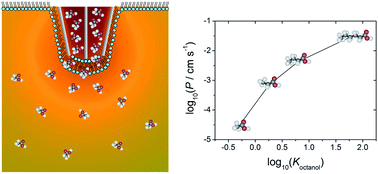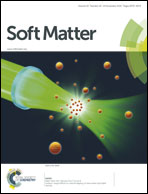A new approach for the fabrication of microscale lipid bilayers at glass pipets: application to quantitative passive permeation visualization†
Abstract
A new method of planar bilayer lipid membrane (BLM) formation is presented that allows stable, solvent-free lipid bilayers exhibiting high seal resistances to be formed rapidly, easily and reproducibly. Using these bilayers the passive permeation of a series of carboxylic acids is investigated, to determine quantitatively the trend in permeability with lipophilicity of the acid. BLMs are formed at the tip openings of pulled theta pipets, and the rate of permeation of each carboxylic acid across the bilayer, from within the pipet into the bulk solution is determined. This is achieved through spatially-resolved measurements of the pH change that occurs upon the permeation of the weak acid, visualized using a pH-sensitive fluorophore with a confocal laser scanning microscope. The extracted fluorescence profiles are matched to finite element method (FEM) simulations, to allow the associated permeation coefficient for each weak acid to be determined with high accuracy, since this is the only adjustable parameter used to fit the experimental data. For bilayers formed in this way, the weak acids show increasing permeability with lipophilicity. Furthermore, the arrangement allows the effect of a trans-membrane electric field on permeation to be explored. For both propanoic and hexanoic acid it is found that an applied electric field enhances molecular transport, which is attributed to the formation of pores within the membrane.


 Please wait while we load your content...
Please wait while we load your content...